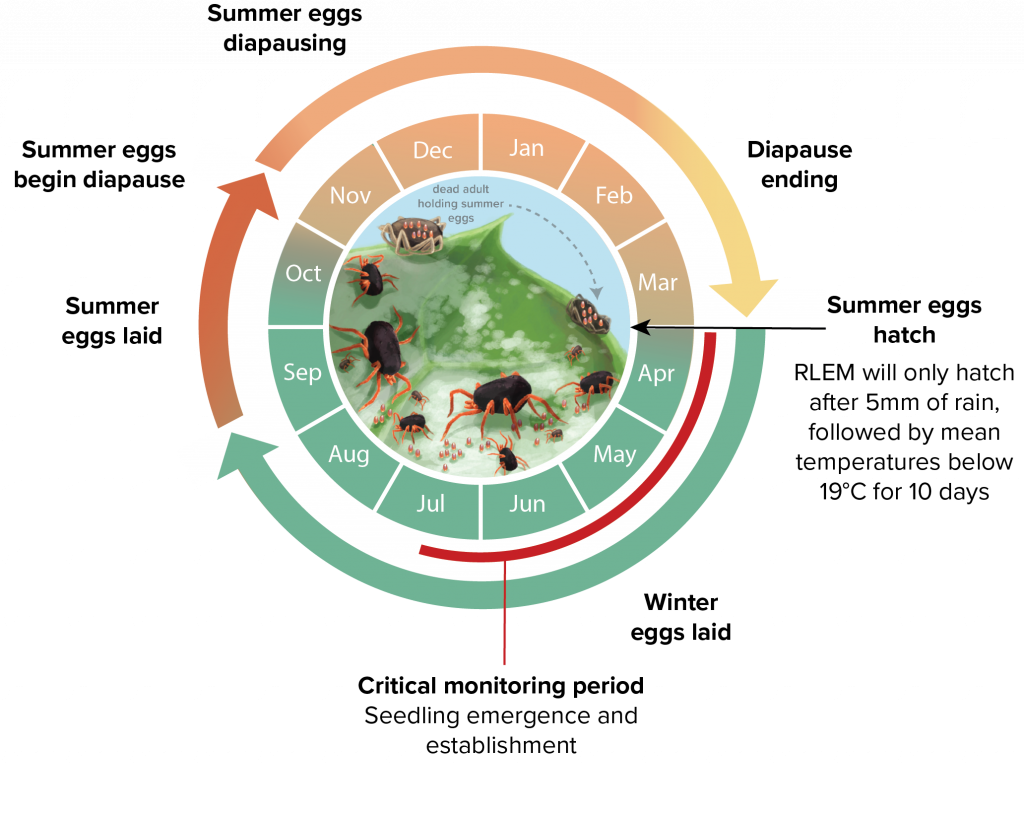The redlegged earth mite (Halotydeus destructor) is not a big fan of summer.
During the hot, dry months when there is little food available, they exist as diapause eggs (in a state of suspended development) that do not hatch until cool, wet conditions arrive again in autumn.
These diapause eggs are extremely tough, enabling the local mite population to persist into the next winter growing season.
They can also be picked up by dust storms during summer, which will transport eggs to new locations.
Limiting the number of diapause eggs laid during spring is a good strategy for high risk paddocks.
High risk situation:
- Current legume dominant pasture or medic/canola
- Next season planting will be legume dominant pasture or medic/canola
- Broadleafed weeds are common in the paddock, or at the edges (particularly capeweed)
- Current canopy is dense, creating an ideal environment for mites
- RLEM is common in the paddock
The laying of diapause eggs is triggered by environmental cues, and scientists have developed a model called Timerite® to predict when this happens and provide an indicator for when spraying should occur (if necessary).
Is the time right?
Timerite® is an online tool that primarily uses day length to inform growers and advisors when redlegged earth mite will start producing diapause eggs during spring and provides location specific spray dates. This gives growers a window of opportunity to strategically target redlegged earth mite-problem paddocks.

Optimum dates for redlegged earth mite control in eastern Australia are mostly between mid-September to mid-October. Exact dates are available through the Timerite model.
The date for spring spraying is unique to each property and remains constant from year to year. It is recommended that spraying be carried out within the two-week period before the optimal date.
Some examples of the recommended date are:
Wagga Wagga NSW – 29 September
Cootamundra NSW – 14 October
Benalla VIC –12 October
Hamilton VIC – 15 October
Note that blue oat mites (Penthaleus spp.) are active during the same time of year as the redlegged earth mite and also diapauses over summer. However, unlike redlegged earth mite, TimeRite® is not effective against blue oat mites, which produce diapause eggs throughout autumn, winter and spring (see video below for assistance identifying mites).
Be strategic with this timely recommendation
Redlegged earth mite is steadily developing resistance to insecticides in Australia. We don’t encourage annual, routine spraying on the Timerite® date.
Think of it as one tool out of several that can be used in paddocks where redlegged earth mite numbers have built to high numbers and the risk to the future crop is high.
Currently, achieving an effective spring-spray is mostly reliant on using an insecticide with systemic and residual properties such as dimethoate or omethoate, which are broad spectrum and disrupt the lifecycles and activity of beneficial natural enemies.
Judicious use of available chemistries and consideration of other management tactics is a must!
Cover image: Photo by Cesar Australia





